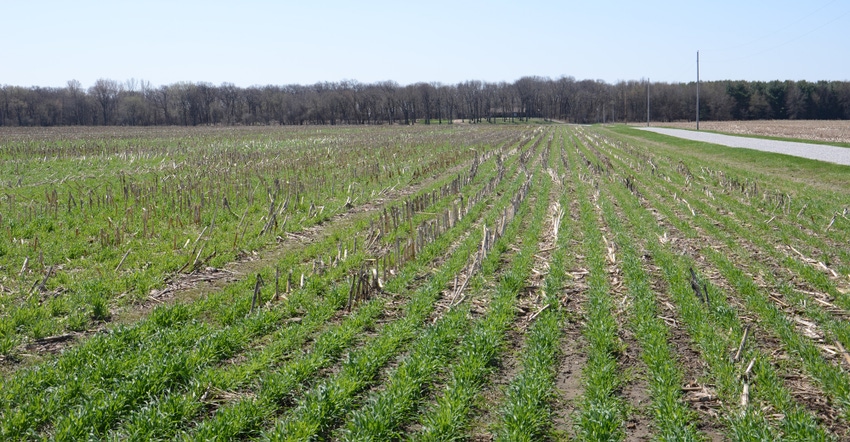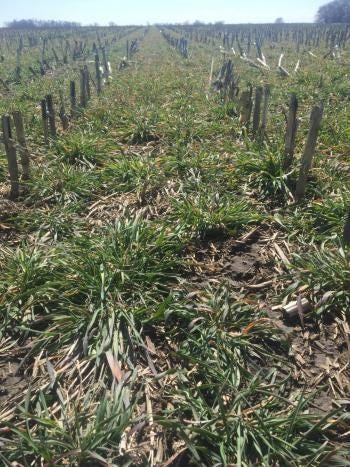March 26, 2020

As temperatures warm this spring, cover crop termination is on the to-do list for some Iowa fields. Killing cover crops with herbicides is the most common termination method. The effectiveness of herbicides at terminating a cover crop depends primarily on three things:
Cover crop species and growth stage
Herbicide and rate used
Environment
The cool and fluctuating temperatures encountered in spring often make terminating cover crops challenging. Farmers are limited to a few products like paraquat (Gramoxone; group 22), glufosinate (Liberty; group 10), or glyphosate (Roundup; group 9) for cover crop termination. Glyphosate is the most consistent option for termination, especially as cover crops increase in size. The group 1 herbicides (e.g. clethodim, fluazifop, etc.) do not provide effective control of cereal rye. If cereal rye or other grass species are seeded with a legume, inclusion of 2,4-D or dicamba with glyphosate will improve consistency of control. This addition can also be helpful if broadleaf winter annuals are present.
In a study encompassing eight site-years across five states, treatments containing glyphosate provided the most consistent cereal rye control (Figure 1). Cereal rye ranged from 5-54 inches tall at termination in the experiments. While control of cereal rye did not differ statistically between most paraquat and glyphosate treatments, paraquat-based treatments were much less consistent than glyphosate-based treatments. Glufosinate treatments were less effective and less consistent than glyphosate treatments. While paraquat can provide acceptable control in some situations, neither glyphosate alternative (paraquat, glufosinate) provides as consistent control as glyphosate under the cool and variable spring conditions. Dicamba combinations with the three burndown herbicides provided similar results to 2,4-D combinations (data not presented).

Figure 1. Control of cereal rye cover crops with select herbicide treatments.
* represents treatment mean; box represents the mid 50% of the data set, providing information on consistency of treatments. Herbicide rates: glyphosate: 1.0 lb/A; paraquat: 0.75 lb/A; glufosinate: 0.5 lb/A; 2,4-D: 0.5 lb/A; saflufenacil: 1 oz/A; metribuzin: 0.12 lb/A. Herbicides applied in 15 gal/A. Adapted from Whalen et al. 2020.

Figure 2. Cereal rye cover crop at the ISU McNay Farm planted early September 2017. Photo taken March 30, 2018.
Vegetative growth in rye requires temperatures of at least 38 F. While air temperatures may be favorable some days, cool soil temperatures can slow growth. Herbicides are most effective on actively growing plants; thus, very early spring termination treatments may provide less than complete control. Leaving a small check strip is a simple and easy way to see if the cover crop is dying following termination.
Iowa State University researchers generally recommend terminating the cover crop with herbicide 10 -14 days prior to planting corn to protect yield; however, that time frame is less critical for soybeans. Waiting to terminate until after your crop is planted, especially in non-GMO corn, can be risky. Termination options are more limited, and the cover crop can quickly become an uncontrollable weed in non-GMO crops. Additionally, it is important to check with your crop insurance agent for any specific cover crop requirements that they may have prior to planting corn or soybeans.
Always look at the herbicide labels for directions and any restrictions for the subsequent crop. A quick and easy place to look up herbicide labels is www.cdms.net or www.greenbook.net.
Source: Iowa State University, which is solely responsible for information provided and is wholly owned by the source. Informa Business Media and all of its subsidiaries are not responsible for any of the content contained in this information asset.
Read more about:
HerbicideYou May Also Like




